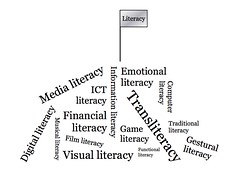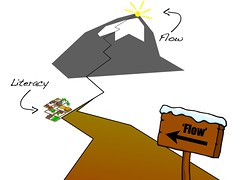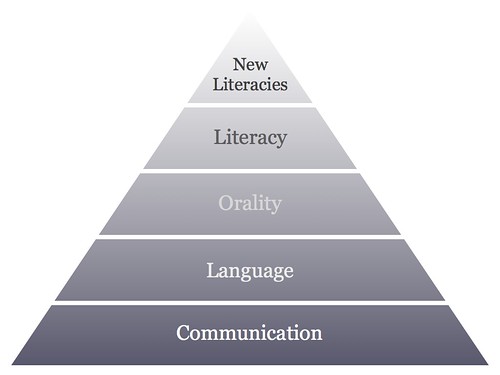Literacy -> Digital Flow: The Autotelic Self
This continues from my previous posts on Literacy -> Digital Flow. References can be found at http://dougbelshaw.com/wiki
CC BY-NC-SA DareMo Shiranai
Is the word ‘literacy’ useful? Literacy is a state which has traditionally been ascribed (or not) to individuals. Is the state that writers on ‘New Literacies’ espouse simply a case of encoding and decoding texts? It would appear from the above, given the references to ‘identity’ and ‘community’ that perhaps we have moved beyond literacy. An idea to be explored in what follows is that a digital version of the concept of Flow may be a Pragmatically-useful concept to use in place of the seemingly never-ending ‘umbrella terms’ outlined earlier.
In his seminal book of the same name, Mihaly Csikszentmihalyi introduced flow as being at the root of true happiness, successful learning experiences and what can loosely be termed ‘intrinsic motivation’. In a state of flow, individuals undergo what Csikszentmihalyi refers to as ‘the autotelic experience’:
The term “autotelic” derives from two Greek words, auto meaning self, and telos meaning goal. It refers to a self-contained activity, one that is done not with the expectation of some future benefit, but simply because the doing itself is the reward… Most things we do are neither purely autotelic nor purely exotelic (as we shall call activities done for external reasons only), but are a combination of the two. (Csikszentmihalyi, 1990, 2008:67)
Focusing on the term ‘literacy’ and attempting to shoehorn 21st-century behaviours, technologies and attitudes into the concept could lead to anachronism. Literacy, as we have seen, is predicated upon technologies used to encode and decode texts. The reason Traditional Literacy was such a stable concept with a definite meaning in the minds of most people was due to it built upon a technology that did not change significantly in hundreds of years. It is the pace of innovation in new technologies that has caused a problem for conceptions of literacy.
If instead of a ‘top-down’ approach to literacy (‘x, y and z consitute literate activities’) a ‘bottom-up’ approach was considered this could potentially side-step the difficulty caused by the pace of technological change. The reason that concepts such as ‘digital literacy’, ‘cyberliteracy’, ‘new literacies’ and the like have been proposed is to give a name to a socially useful state to which individuals can aspire. Given that most proponents of such terms would agree that their thinking is built upon Traditional Literacy, it would seem that using ‘literacy’ as an epithet for these extra skills, abilities and behaviours is unnecessary.
What may be more useful in a Pragmatic sense may be to assume Traditional Literacy and combine these skills with digital tools and sociocultural practices that lead to socially and educationally-useful outcomes. Instead of viewing a ‘digital’ version of literacy as a pinnacle to be achieved or surmounted, the focus would be on Flow. When dealing with digital ‘texts’ (loosely defined) this would result in Digital Flow depending upon literacy. Literacy becomes a staging-post on the journey instead of the destination itself:
Mass education – as developed in the 19th century – served to instil a minimum standard through drill-and-practice within the realm of Traditional Literacy. Some have likened this to a factory model with Taylorism as its guiding principles. This is slightly unfair, given the constraints, social problems and political landscape of the time, but does throw light upon how debates surrounding the purpose of education have shifted. It is no longer enough to ensure that young people leave school with the ‘3Rs’. Indeed, under initiatives such as Ofsted’s Every Child Matters (ECM), wider concerns such as children’s (mental) health, and their ability to achieve ‘economic wellbeing’ have necessarily been brought to the forefront of planning and curriculum design in UK schools.
Despite this, skills and abilities in almost every area of the curriculum are, somewhat indiscriminately, designated ‘literacies’. Courses are designed around concepts as ‘health literacy’, ‘financial literacy’ and ’emotional literacy’ as a shorthand to convey action relating to the ECM agenda. It may be more productive and instructive to replace this ‘scatter-gun’ approach to literacy with a more far-reaching commitment towards helping young people develop their ‘autotelic self’:
A person with an autotelic self learns to make choices… without much fuss and the minimum of panic… As soon as the goals and challenges define a system of action, they in turn suggest the skills necessary to operate within it… And to develop skills, one needs to pay attention to the results of one’s actions – to monitor the feedback… One of the basic differences between a person with an autotelic self and one without it is that the former knows that it is she who has chosen whatever goal she is pusuing. What she does is not random, nor is it the result of outside determining forces. (Csikszentmihalyi, 1990, 2008:209)
Instead of having to continually widen and redefine literacy to cater for new technologies and methods of social interaction, a focus on Digital Flow would be consistent with the idea of ‘liquid modernity’. It would serve to end the idea of a ‘life-project’ being something external to the individual and encourage individuals to embrace short-term, pragmatic strategies when approaching digital technologies (Martin, 2008:153). Digital Flow is focused on the creative act, as opposed to never-ending definitions of literacy predicated on the consumption of media or physical goods. As a result, Digital Flow can be considered the ‘umbrella-term’ for which theorists have been grasping and over which they have been arguing. Moreover, it can be seen as a coherent target at which to aim educational experiences.




![Reblog this post [with Zemanta]](http://img.zemanta.com/reblog_e.png?x-id=9b94f2b5-ab5e-4961-8bda-57c51ae674c6)

